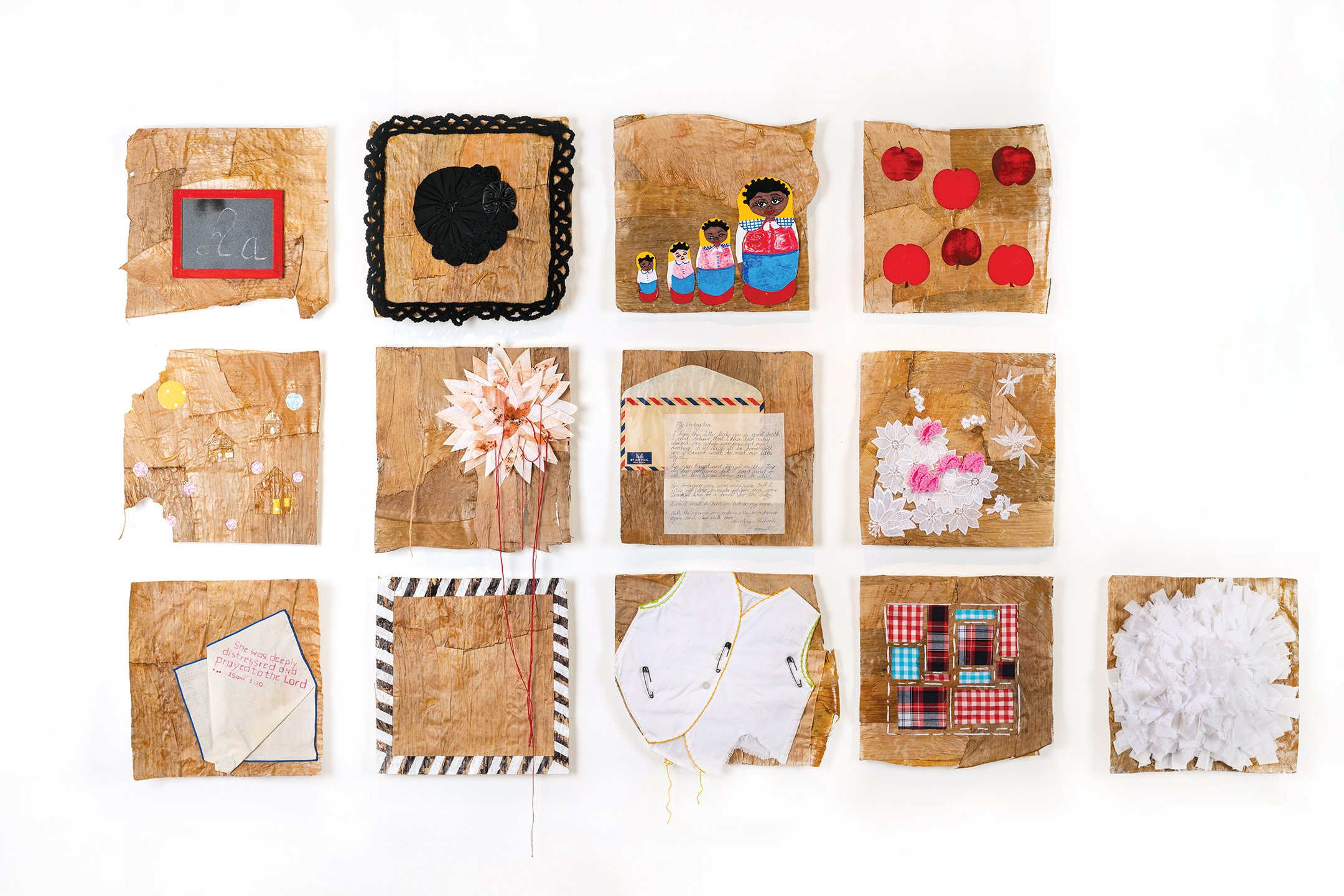
ARTIST, NASARIA SUCKOO CHOLLETTE,
CAYMAN ISLANDS
‘ONE WHO HELPS’
ARTIST, NASARIA SUCKOO CHOLLETTE, CAYMAN ISLANDS
A poet, storyteller and visual artist, Nasaria Suckoo Chollette’s extensive and varied body of work is as vibrant, passionate and empathetic as she is.
Words by Natasha Were. Photos courtesy of the National Gallery of the Cayman Islands.
Whether through the written or spoken word, paintings, collages or art installations, Nasaria Suckoo Chollette’s creations are inspired and informed by Cayman’s history and culture.
By carefully weaving long-forgotten stories and everyday practices into her work, she has become a guardian of Caymanian heritage, preserving the memory of a way of life that has all but disappeared. But her work is about more than simply celebrating the past: it also tackles some uncomfortable truths, inviting viewers to acknowledge both the good and bad aspects of Cayman’s history and to consider a more compassionate way forward.
Her recent solo exhibition at the National Gallery of the Cayman Islands showcased the breadth and scope of her visual art. Although contemporary in style and characterised by vivid colours and rich textures, the exhibition was primarily concerned with age-old customs, the role of women in society, Cayman’s history of slavery and its after-effects. The title, All the Coals We Left in the Fire, alludes both to the traditional practices depicted in her works, and also the elements of our past that have been swept under the rug rather than addressed.
Growing up in Grand Cayman in the 1970s, Nasaria Suckoo Chollette experienced island life when it was still simple, quiet and traditional. With no television at home, she and her siblings created their entertainment, playing outdoors, building camps, fighting mock battles or escaping into other worlds through books.
A sensitive and empathetic child, she would be deeply moved by the fate of fictional characters in the stories she read and, even at a young age, found release in creating. “Anything I felt,” she says, “became either a painting, a little poem or sometimes a collage.”
She didn’t immediately pursue an artistic career, however. “From the time I was in high school, there were two things I liked: social work (because I was always trying to help people) and theatre,” she recalls. “I knew I would struggle not to take home the emotional aspects of social work though. I didn’t want to act, but I loved the creativity of theatre production. And with so many teachers in my family, I knew I wanted to teach, so I chose to study Theatre Education.”
At Howard University, a historically black university, students were taught to view the world through an African American lens, learning about aspects of history that might have been left out of mainstream European curricula. There, she began to question what Cayman’s history was like.
“When I came back and started teaching drama at John Gray High School, my students didn’t have any plays, poems or skits they could perform in their own way of speaking,” she says.
“They didn’t really know where they came from and were just falling into American or Jamaican culture.”
And so, she started researching Caymanian heritage to give her students a base, a cultural identity. Incorporating elements of this into her stories and poems became a way of sharing it ‘in a way that wasn’t preachy’.
Later, art became a vehicle for preserving and celebrating Caymanian heritage. Becoming Again, a piece for which she received the Bendel Hydes award at the first Cayman Islands Biennial, is one such example. A reconstruction of a typical bed of times past, with a wooden frame and a mattress made from ‘plantain trash’ (dried plantain leaves), it’s an exploration of our concept of trash – this ‘trash’ prevented previous generations from sleeping on a hard floor – and of the cycle of death and rebirth. By raising the base of the bed, she says, it looks more like an altar or funeral pyre than a simple bed and invites viewers to think about sacrifices made for comfort.
When, after 17 years of teaching, she moved to the National Museum as Education Coordinator, she dived deeper into her cultural research, interviewing elders, poring over historical records and delving into archives. During that period, she came across reports of an enslaved Caymanian who was beaten for demanding her freedom – a story that inspired her best-known poem, Just Long Celia.
While many prefer to wave that period of history away, Nasaria believes that acknowledging slavery existed in Cayman is essential.
“It doesn’t mean we have to be in a blame game, but we can’t pretend it didn’t exist. As my husband says, slavery is how we got here. And as much as we like to think we’re a friendly, cohesive society, there are consequences that are still being felt today.”
It’s there in the wealth disparities and the prejudices and racism that lie below the surface. She hopes her art will help bring this out of the shadows and encourage viewers to think and talk about it.
Blue Black IV Rise, an installation composed of suspended glass bottles filled with ‘ink’, came out of conversations with older Caymanians, through which she learned that ‘ink stoppahs’ – the stained corks of ink bottles – was a term once used to refer to the darker-skinned residents of George Town. Shocked by the racist terminology, she sought to humanise those ‘ink stoppahs’ and expose those prejudices. At the same time, the fact the bottles are ascending or descending, trailing shells and sea objects, is a reference to the African deity Yemaya – goddess of the river, sea and water – and thus pays homage to the religious beliefs of which enslaved people arriving from Africa were stripped.
“If we don’t acknowledge the past, we can’t build something better together,” she says.
One of her best-known pieces, The Women Have Become the Truth; for Madiba, came to her following the Truth and Reconciliation hearings after apartheid. Deeply affected by the stories of the women who survived, many of whom were rendered mute by the trauma, she says the painting is a self-portrait that flowed out of her. Inspired by Mandela’s desire, “not to punish the perpetrators, but rather to hold them responsible for the care of those they had wronged,” it was a piece born of optimism, the flower bursting from her mouth representing hope, the foetus in the irises a new life, and the corn a bountiful harvest.
An intuitive artist, she sometimes doesn’t know what a piece is destined to become. “I believe some of your strongest work is channelled through you from a higher source, and you’re the vessel for it to come through,” she says. This was the case with Womb Baskets, featuring three baskets shaped like pregnant bellies, made using fine craft techniques. Initially, for Nasaria, it was about women and craftsmanship, she says, but the reaction of others to the piece lent it new meaning. Seeing how the piece resonated with women who had lost children, she realised the piece was actually about helping them to tell their stories and providing some healing. And this, she says, is her purpose. It always has been.
The name Nasaria, of Arabic origin, means ‘one who helps,’ and her whole life, her different careers and her art have all been manifestations of this desire to help. Whenever she has tried to walk an easier path or put herself first, she has been bored, she says. And this is why she does what she does. Her art is not about her: it’s about all the people who come to see it, who connect with it and who are in some way strengthened or comforted by it.
TO VIEW MORE OF NASARIA SUCKOO CHOLLETTE’S WORK
Email: jazzynassy@hotmail.com
Studio by appointment: 16 Astro Close, West Bay, Grand Cayman
Visit: National Gallery of the Cayman Islands
Instgram: @suckoochollette
TO VIEW MORE OF NASARIA SUCKOO CHOLLETTE’S WORK
Email: jazzynassy@hotmail.com
Studio by appointment: 16 Astro Close, West Bay, Grand Cayman
Visit: National Gallery of the Cayman Islands
Instgram: @suckoochollette







